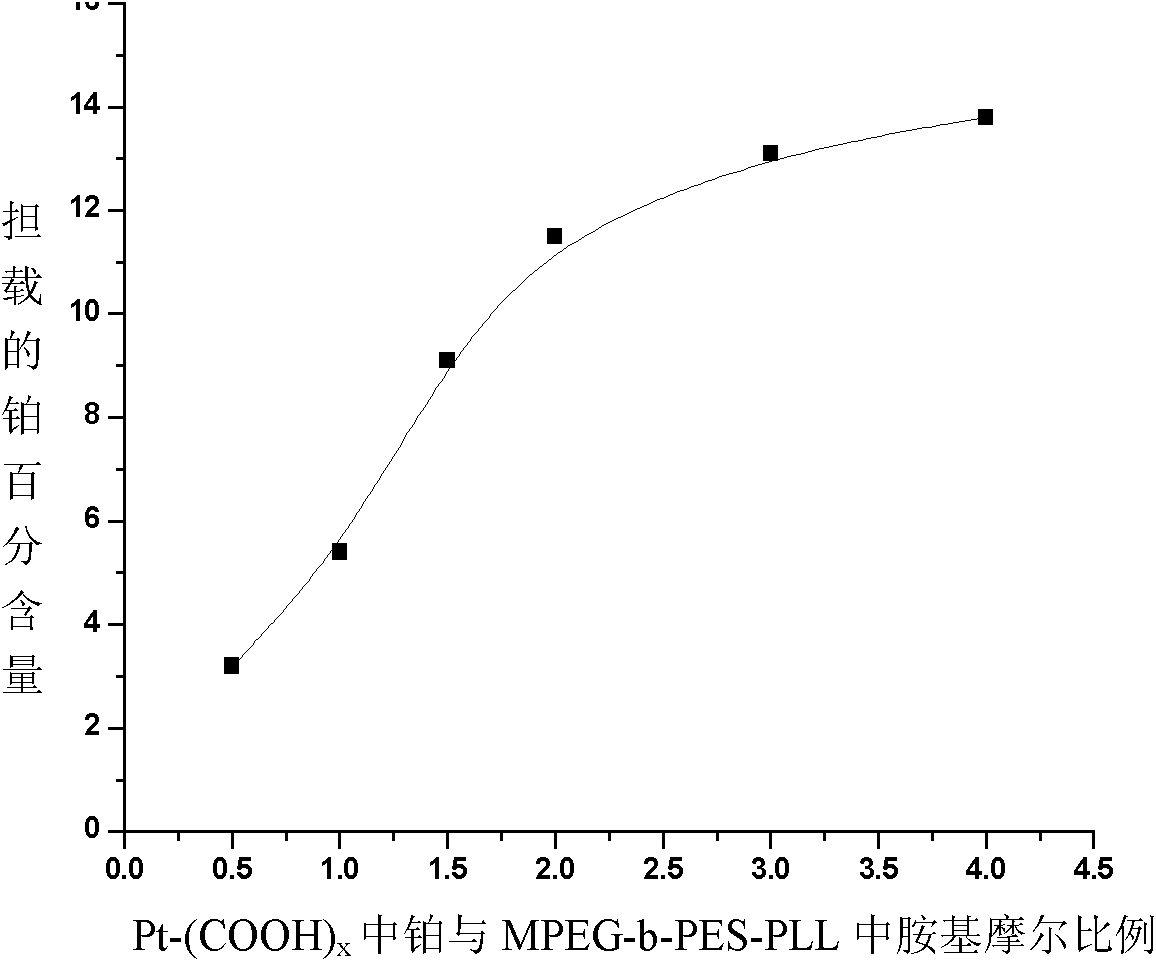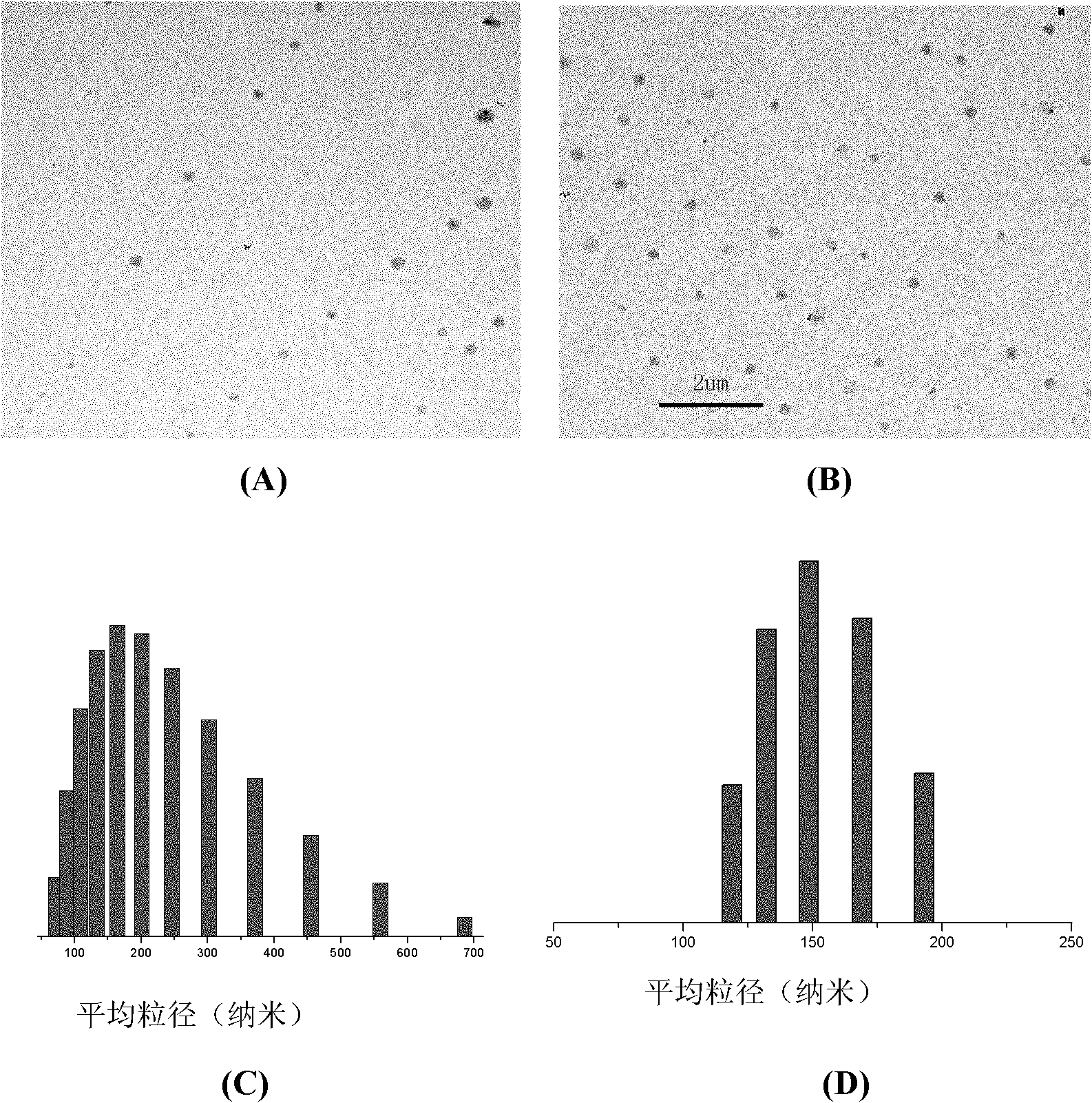Nano micelle of biodegradable macromolecular-bonding Pt(IV) anti-cancer medicament and preparation method thereof
A biodegradable, anticancer drug technology, applied in antitumor drugs, drug combinations, pharmaceutical formulations, etc., can solve problems such as inability to meet use requirements
- Summary
- Abstract
- Description
- Claims
- Application Information
AI Technical Summary
Problems solved by technology
Method used
Image
Examples
Embodiment 1
[0082] Embodiment 1: the preparation of polyethylene glycol-b-polyester block polymer:
[0083] With ε-caprolactone as the cyclic ester monomer, 10 g of polyethylene glycol monomethyl ether with a molecular weight of 5000 was selected as the initiator, dissolved in 50 mL of toluene, and subjected to azeotropic distillation for 1 hour to remove residual water. Add 5gε-caprolactone, then add 100μL of 10% (w / w) stannous octoate toluene solution, stir evenly, heat to 120°C, polymerize for 12 hours and cool to room temperature, dissolve the polymer with 50mL chloroform, and then use 500mL Precipitate the polymer with a methanol / ether mixture with a volume ratio of 1:2; dissolve the precipitated polymer with 50 mL of chloroform, and then use 500 mL of a methanol / ether mixture with a volume ratio of 1:2 for precipitation; the product was vacuum-dried at room temperature for 12 hours. Calculate the polymerization yield by weighing. use 1 The HNMR method determines the molecular weig...
Embodiment 2
[0087] Example 2: Azidation of terminal hydroxyl groups of polyethylene glycol-b-polyester
[0088] Add 10g (1.4mmol) EG to a 500mL reaction flask 5000 -b-PCL 2280 And 0.4mL triethylamine, dissolved with 100mL chloroform under stirring. The reaction flask was cooled in an ice bath at 0°C, and 3.6 mL of 10% (w / v) sulfonyl chloride (CH 3 SO 2 Cl) in chloroform solution, after the reaction was carried out for 4 hours, the reaction product was poured into 500 mL of methanol / ether mixture (volume ratio 1:2) to precipitate a white solid.
[0089] Dissolve the precipitate in 100 mL of N,N-dimethylformamide (DMF), add 1.0 g NaN 3 , stirred at room temperature for 3 days. The solvent was then removed in vacuo, filtered, precipitated, and dried in vacuo to obtain the azidation product MPEG 5000 -b-PCL 2280 -N 3 .
[0090] The kind of polymer and methanesulfonyl chloride, triethylamine consumption, the consumption of sodium azide and the reaction time are listed in Table 3, and ...
Embodiment 3
[0093] Embodiment 3: the terminal azido group of polyethylene glycol-b-polyester is reduced to the terminal amino group, prepares MPEG-b-PES-NH 2 Methods
[0094] MPEG 5000 -b-PCL 2280 -N 3 As an example, the specific operation of the catalytic hydrogenation reaction is as follows: suspend 4g of polyethylene glycol-b-polyester with terminal azidation in a mixed solvent of 50mL of methanol and 300mL of tetrahydrofuran, transfer it to a hydrogenation autoclave, and add Pd(OH) supported on activated carbon 2 Palladium carbon catalyst Pd(OH) with a mass content of 10% 2 / C 600mg, feed hydrogen to make the hydrogen pressure reach 2.5MPa, maintain this pressure and keep constant temperature 50°C, and react for 24 hours. Release the material after pressure release, remove the catalyst by filtration, remove the solvent by evaporation, dissolve with 100mL chloroform, and precipitate 500mL methanol / ether (volume ratio 1:2) mixed solution to obtain MPEG-b-PCL-NH 2 White product, yi...
PUM
 Login to View More
Login to View More Abstract
Description
Claims
Application Information
 Login to View More
Login to View More - R&D
- Intellectual Property
- Life Sciences
- Materials
- Tech Scout
- Unparalleled Data Quality
- Higher Quality Content
- 60% Fewer Hallucinations
Browse by: Latest US Patents, China's latest patents, Technical Efficacy Thesaurus, Application Domain, Technology Topic, Popular Technical Reports.
© 2025 PatSnap. All rights reserved.Legal|Privacy policy|Modern Slavery Act Transparency Statement|Sitemap|About US| Contact US: help@patsnap.com



